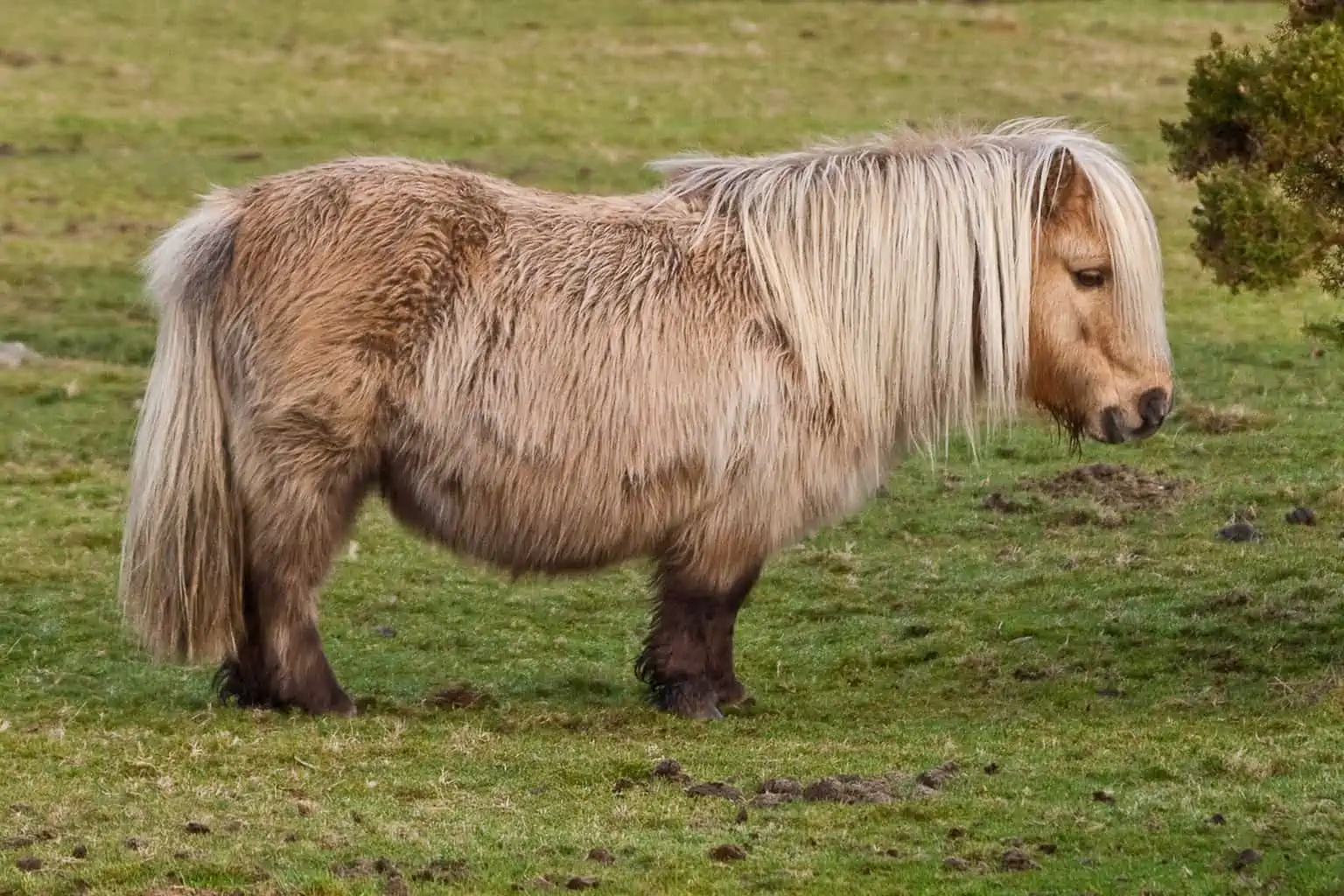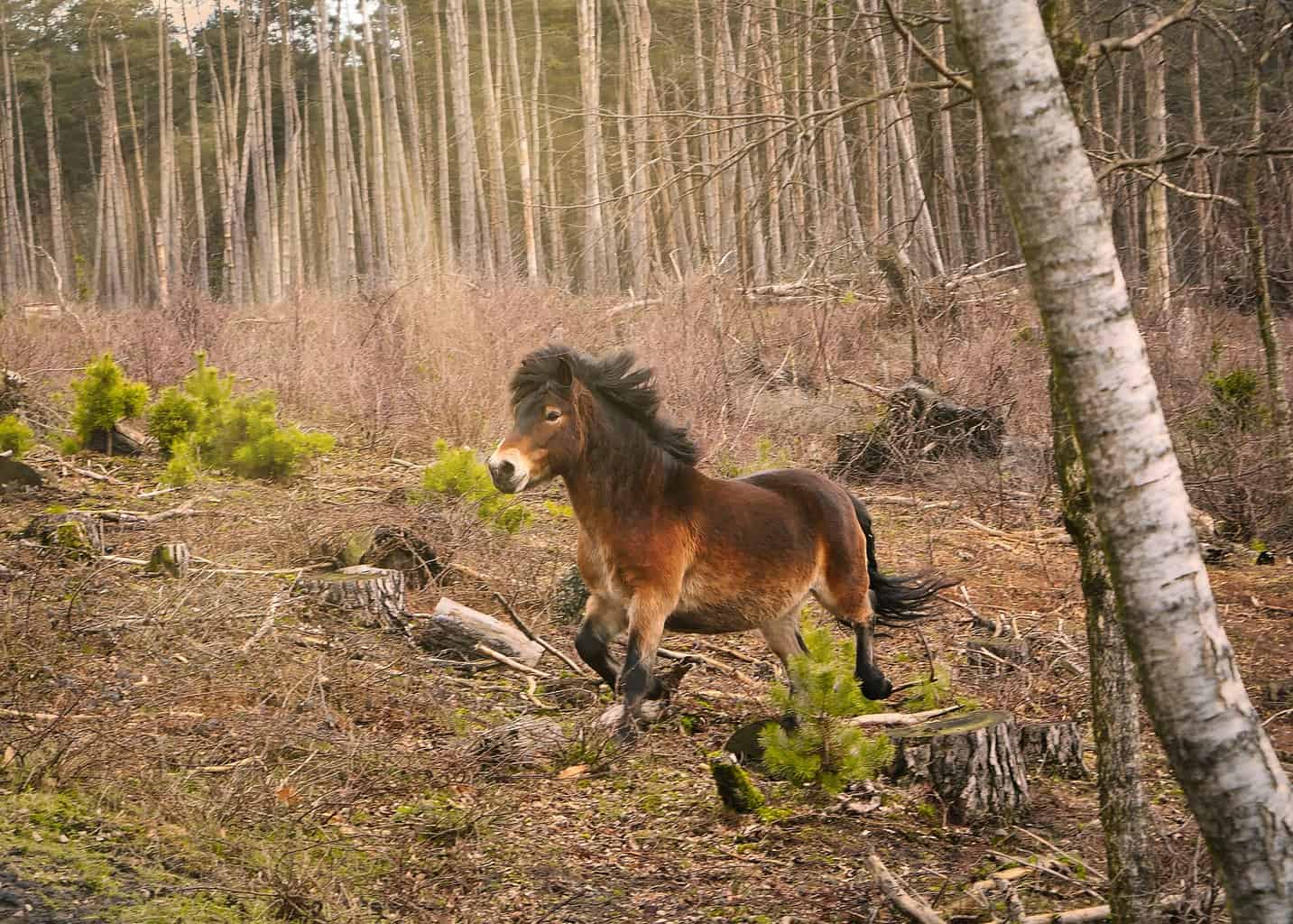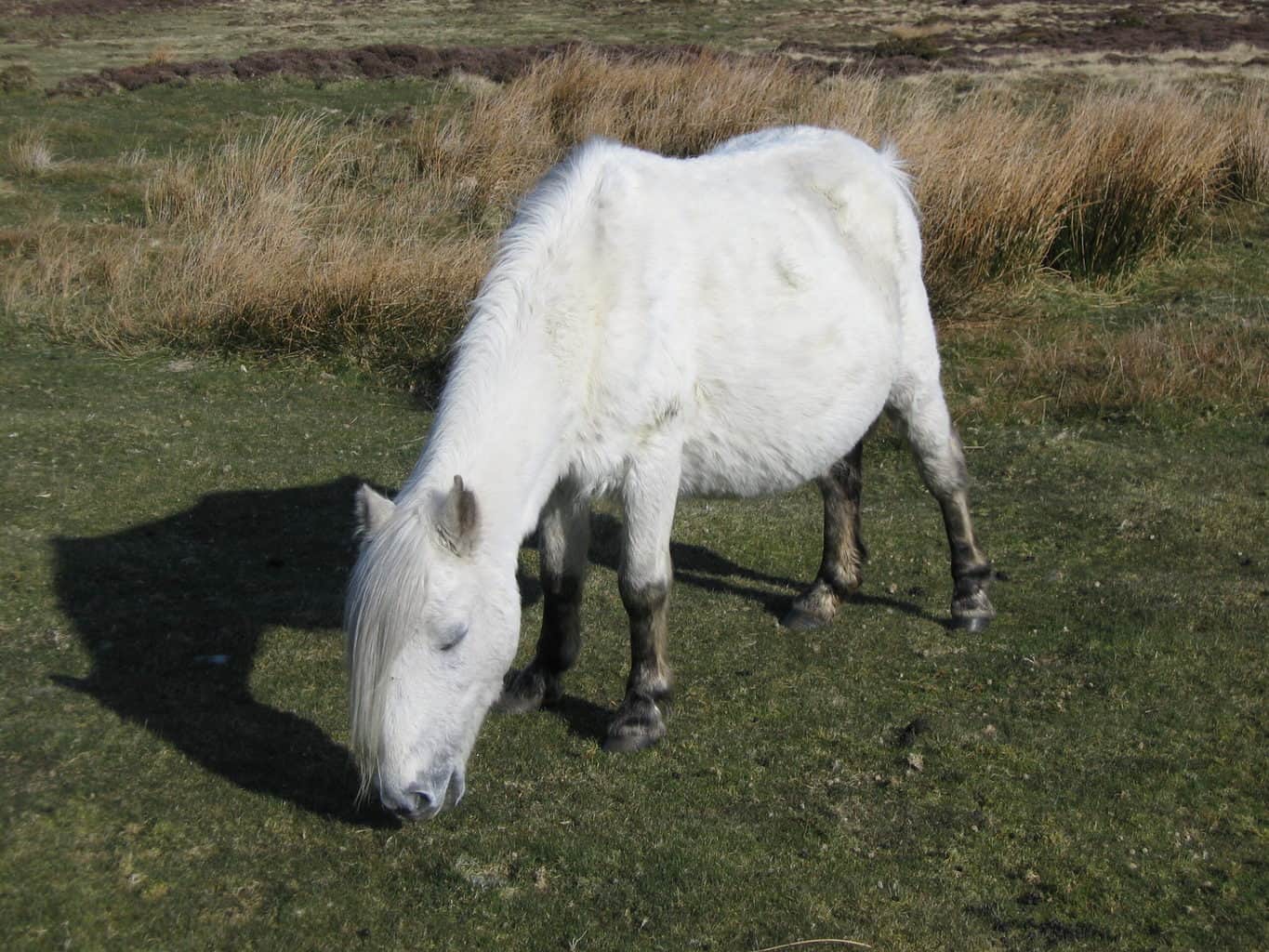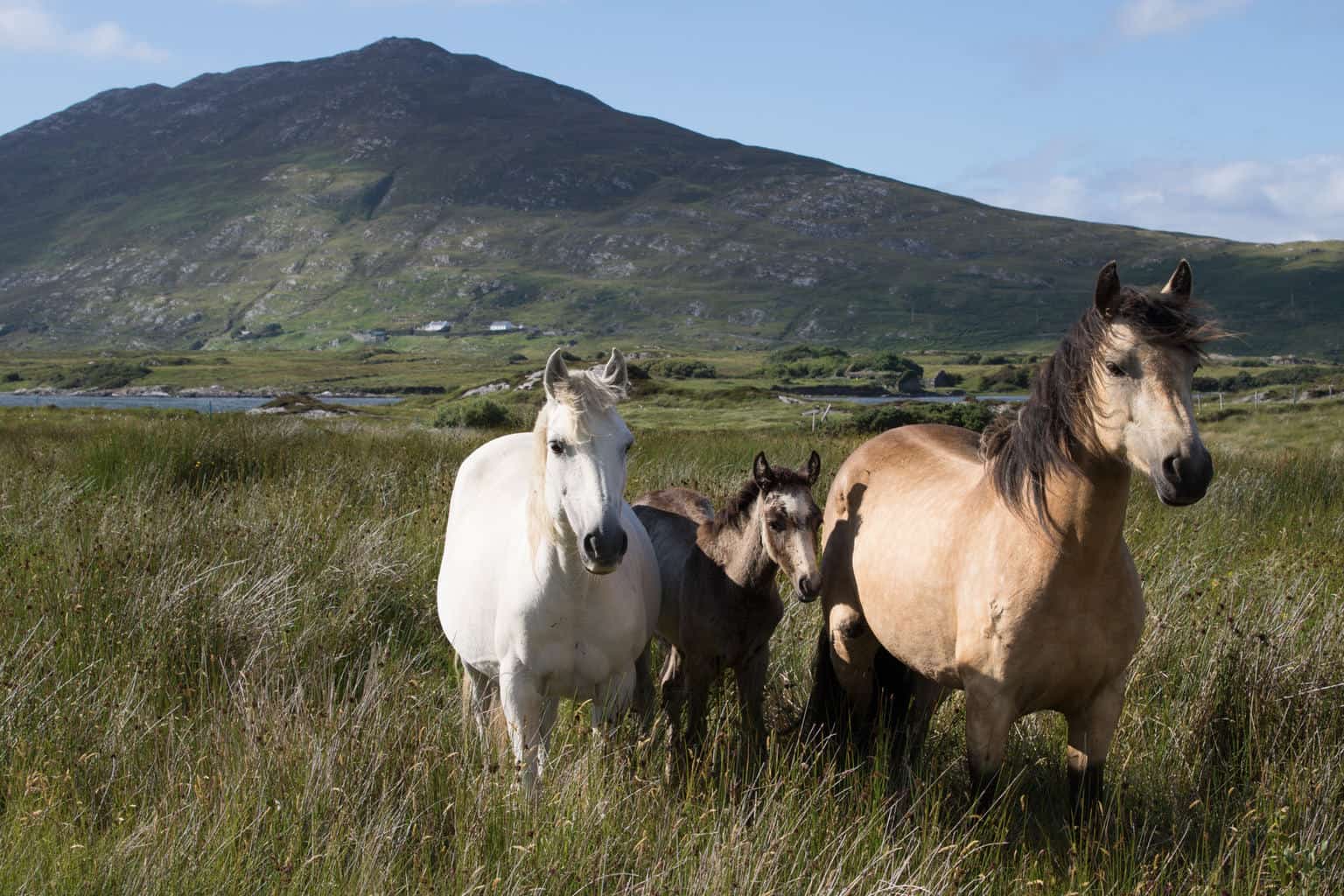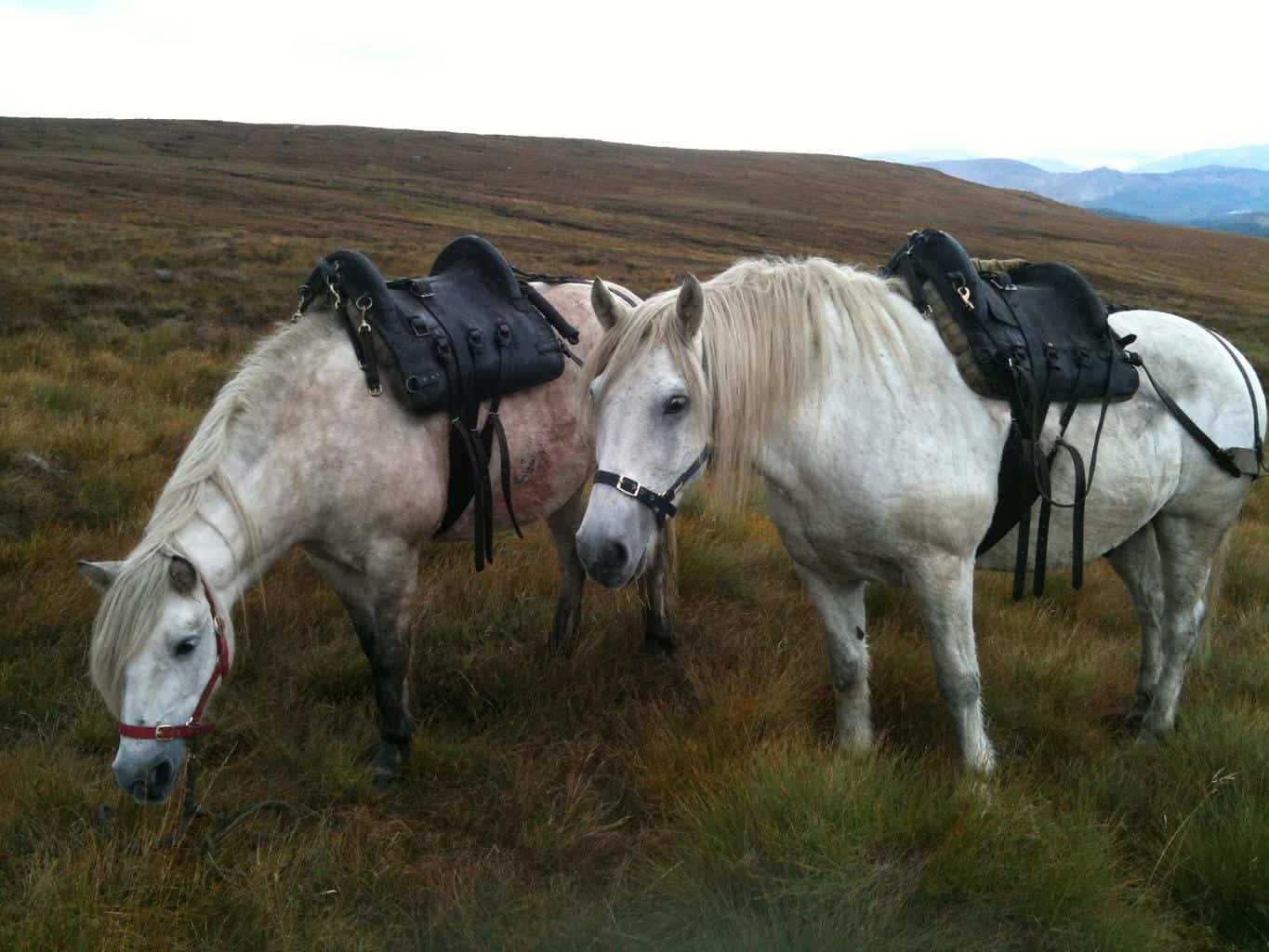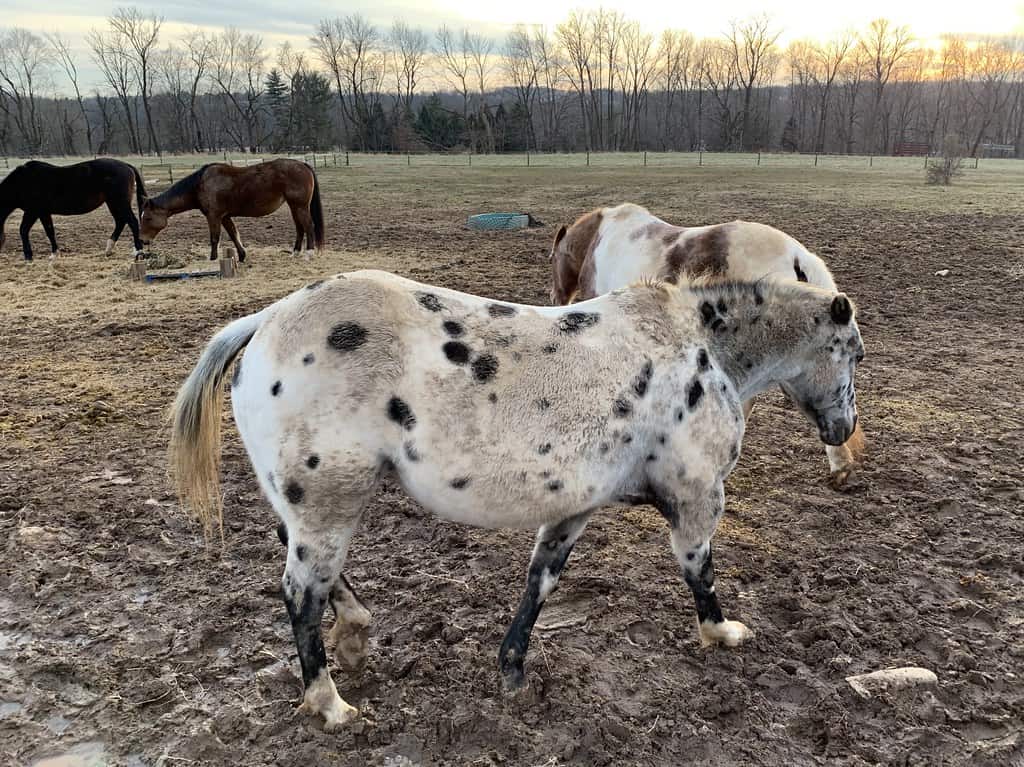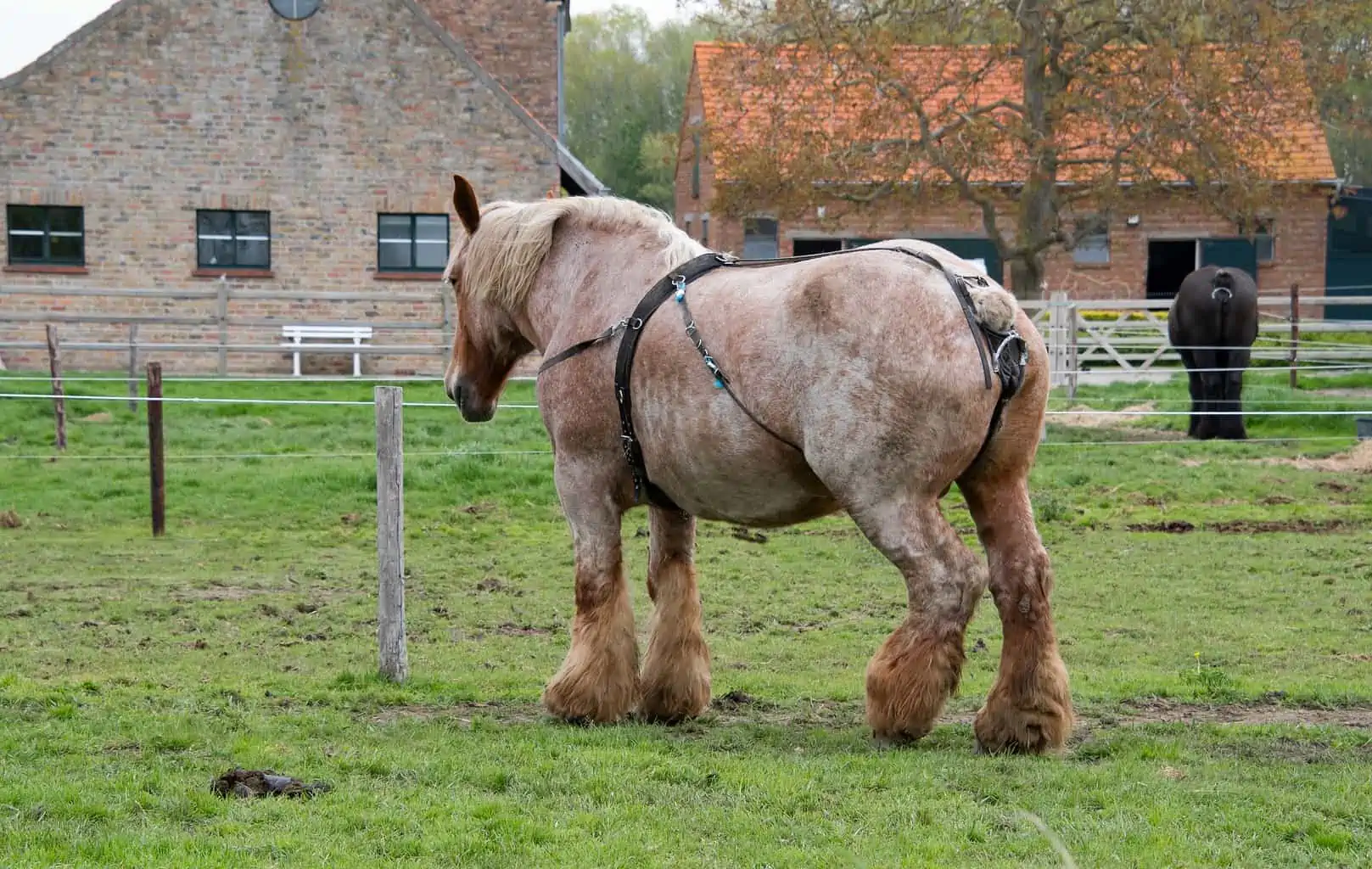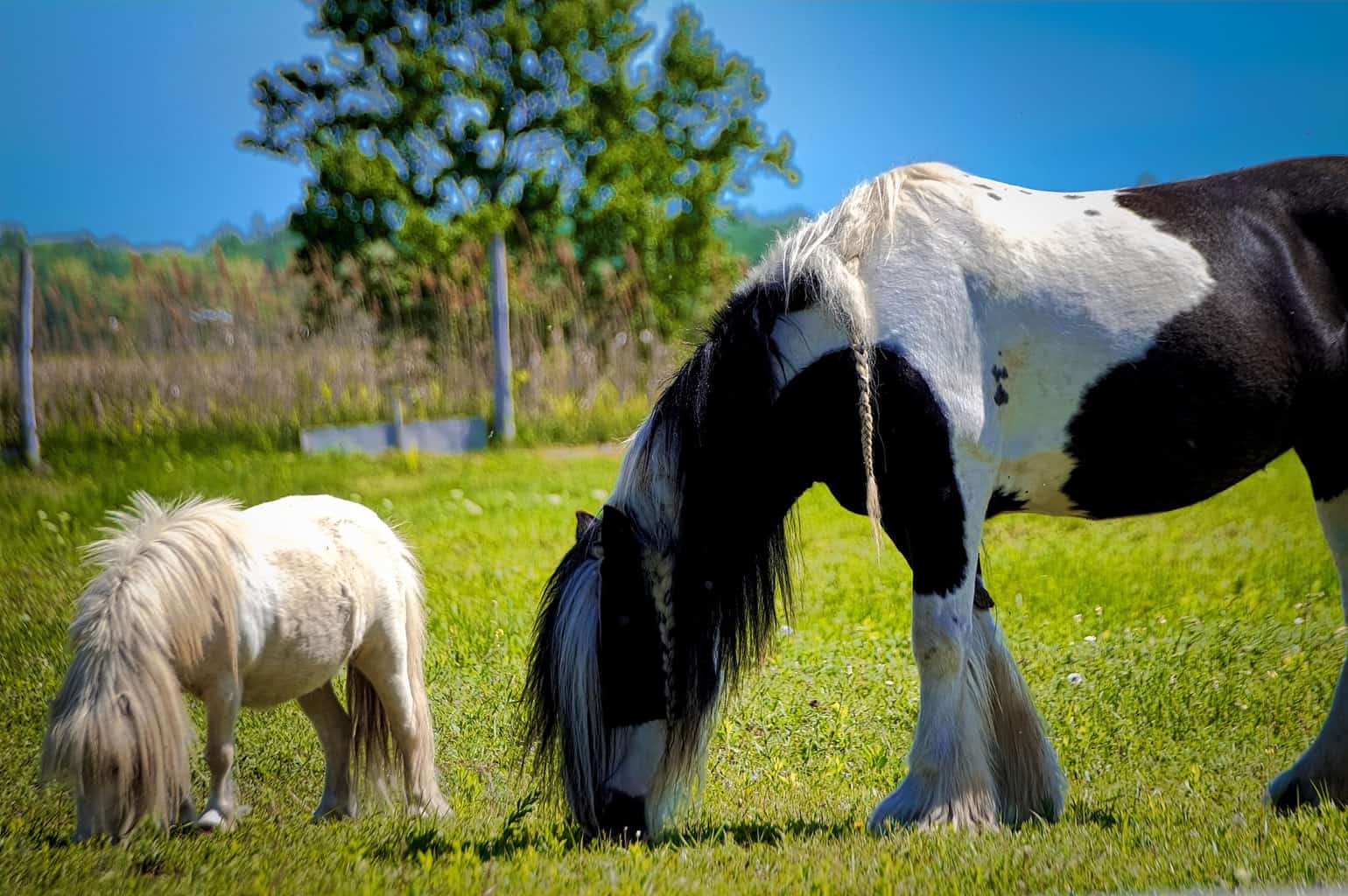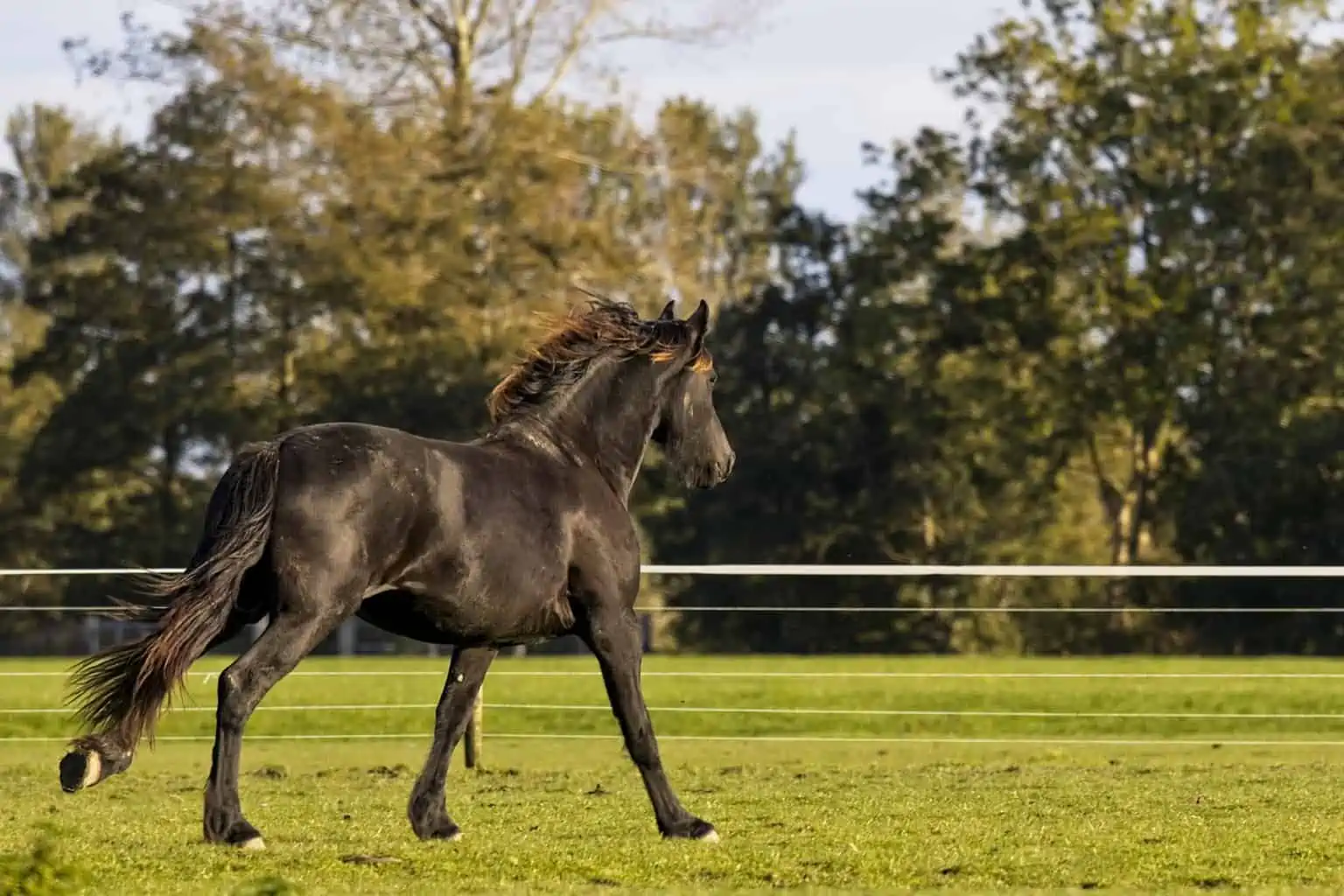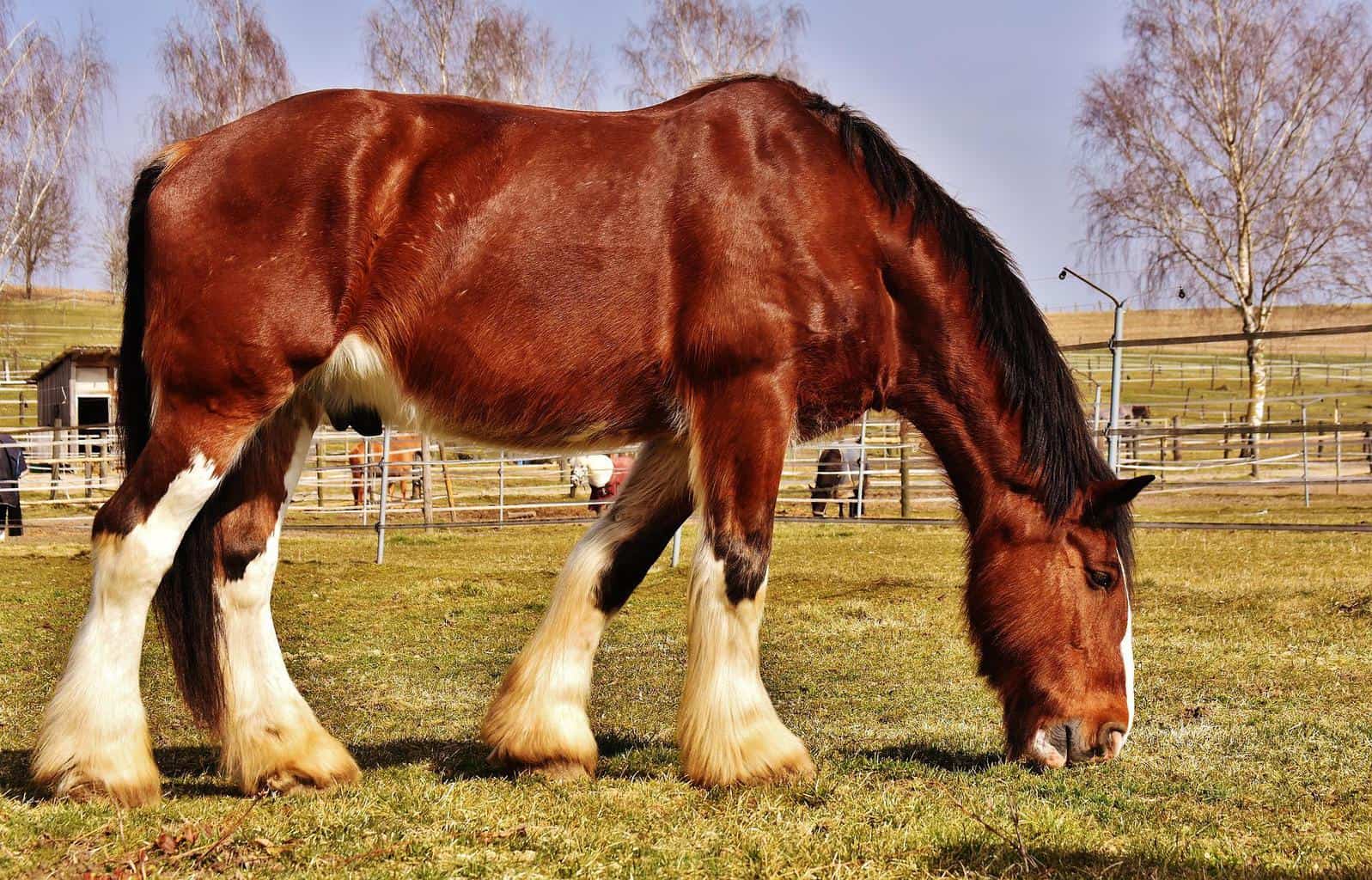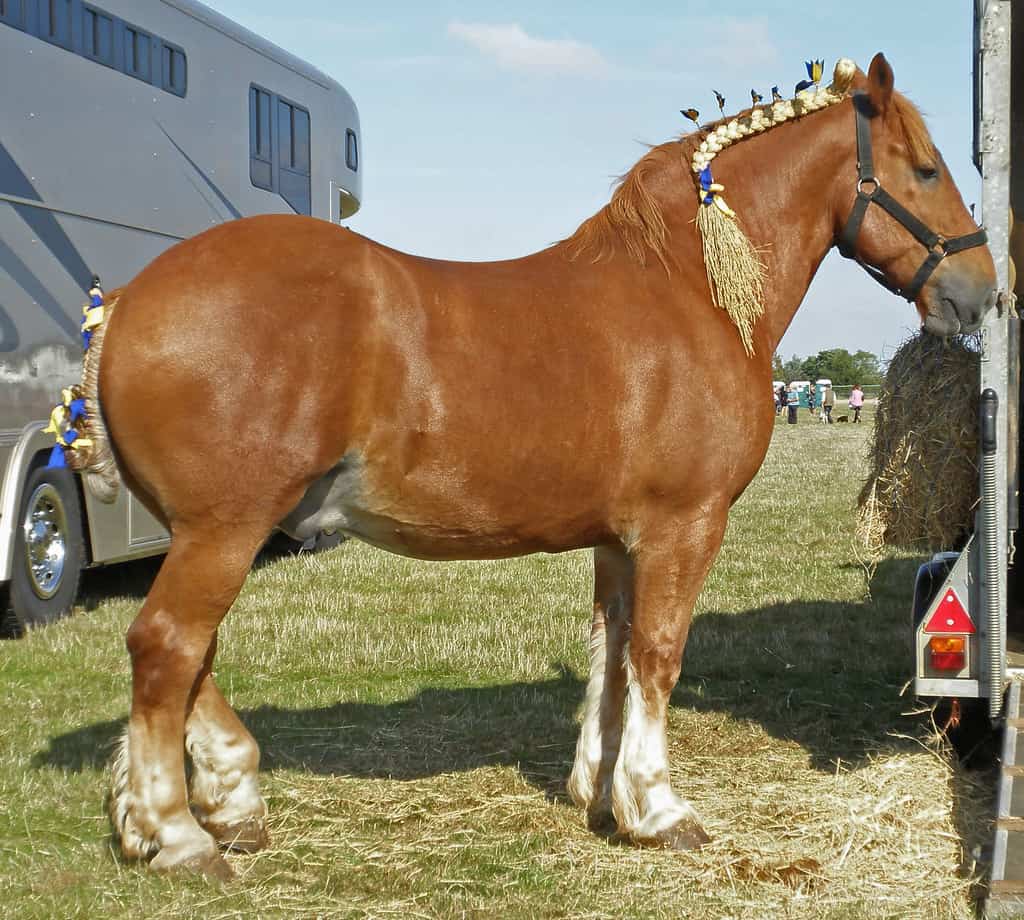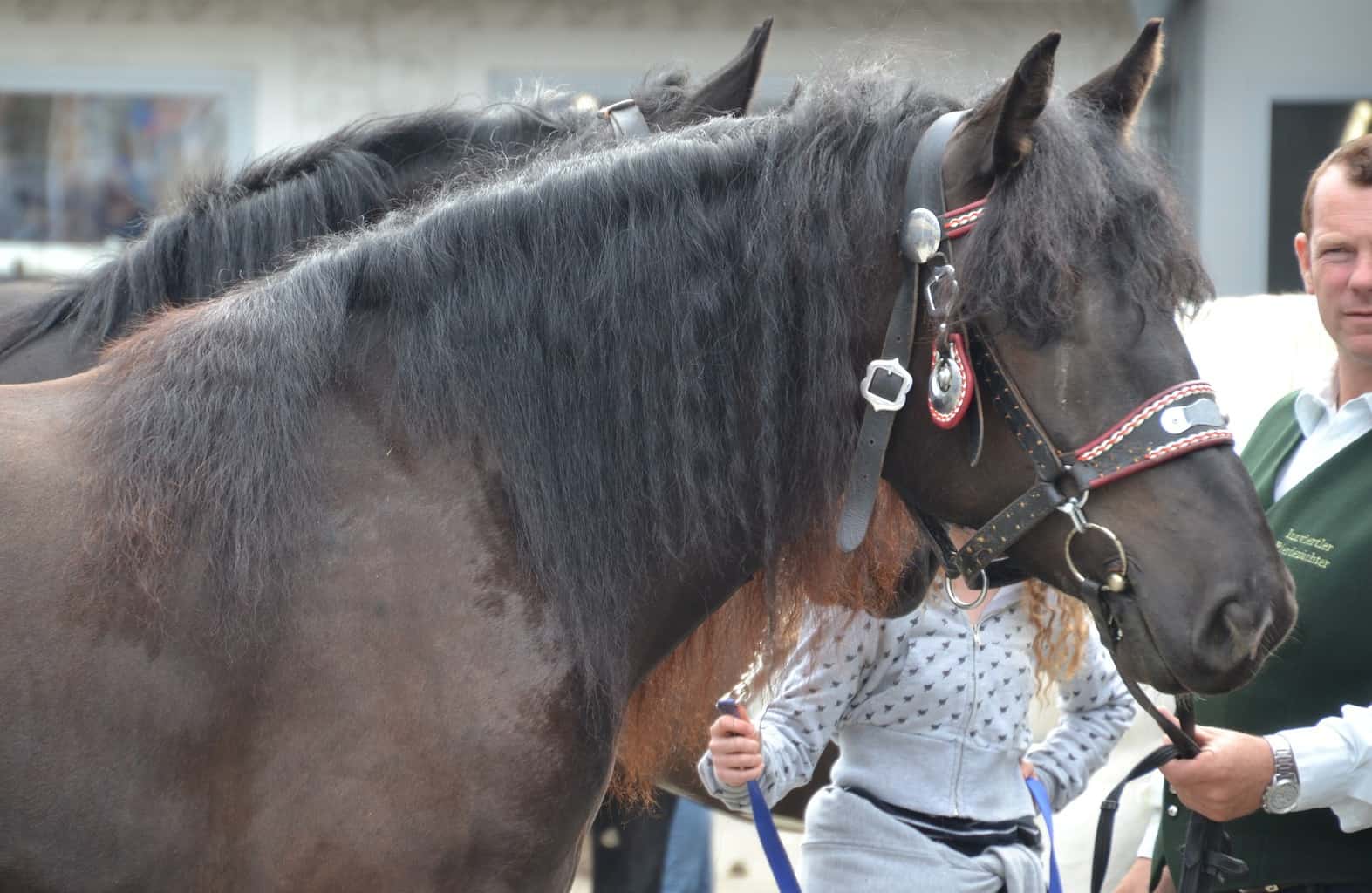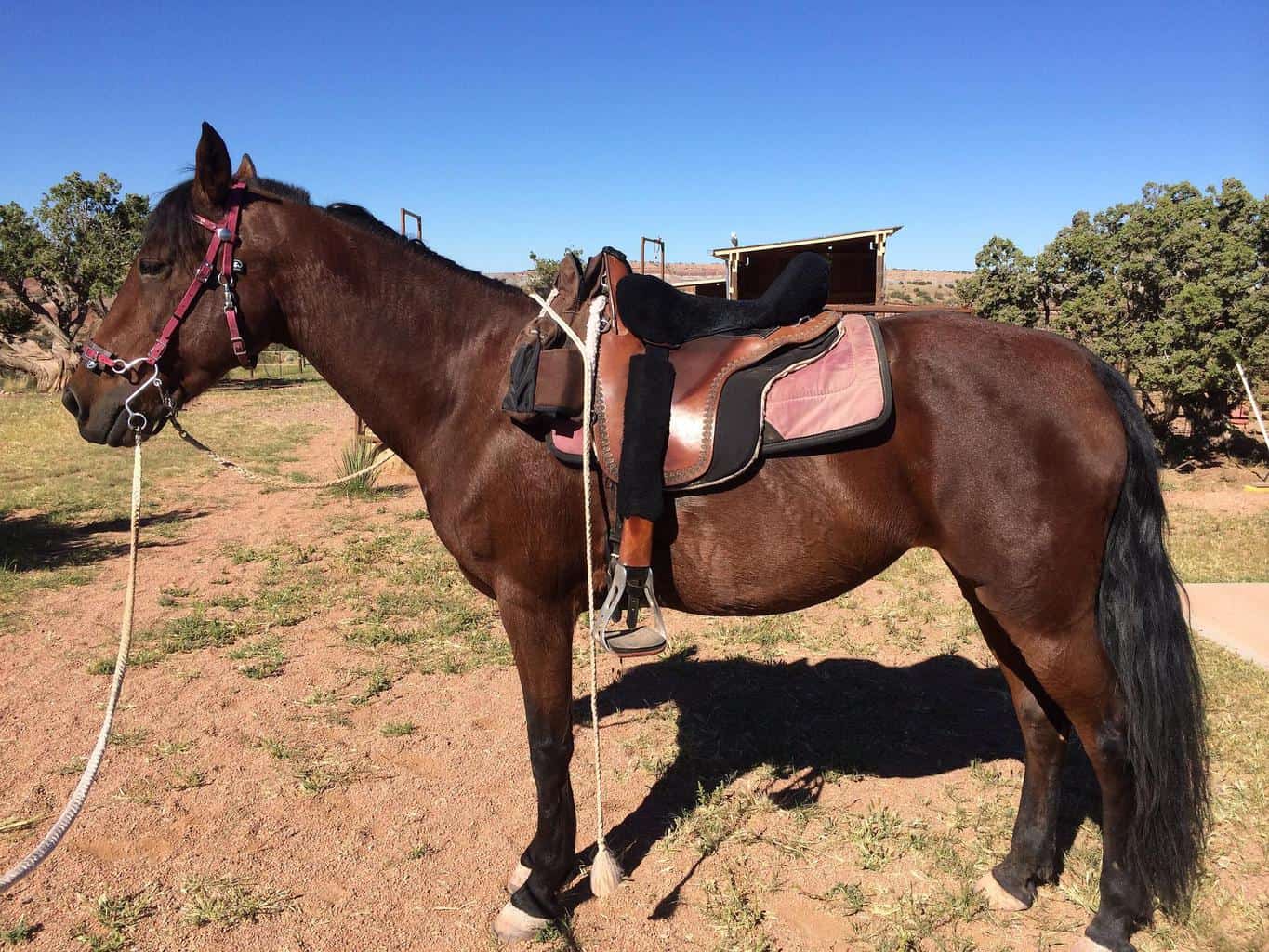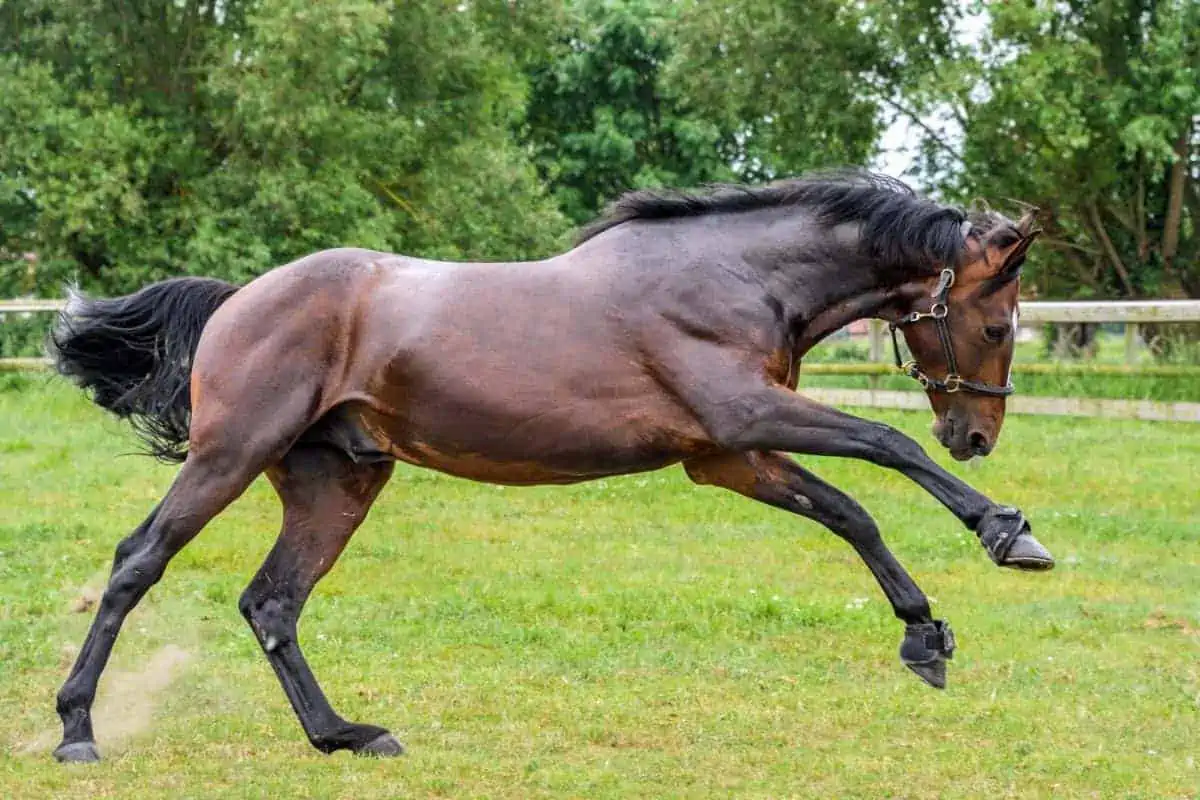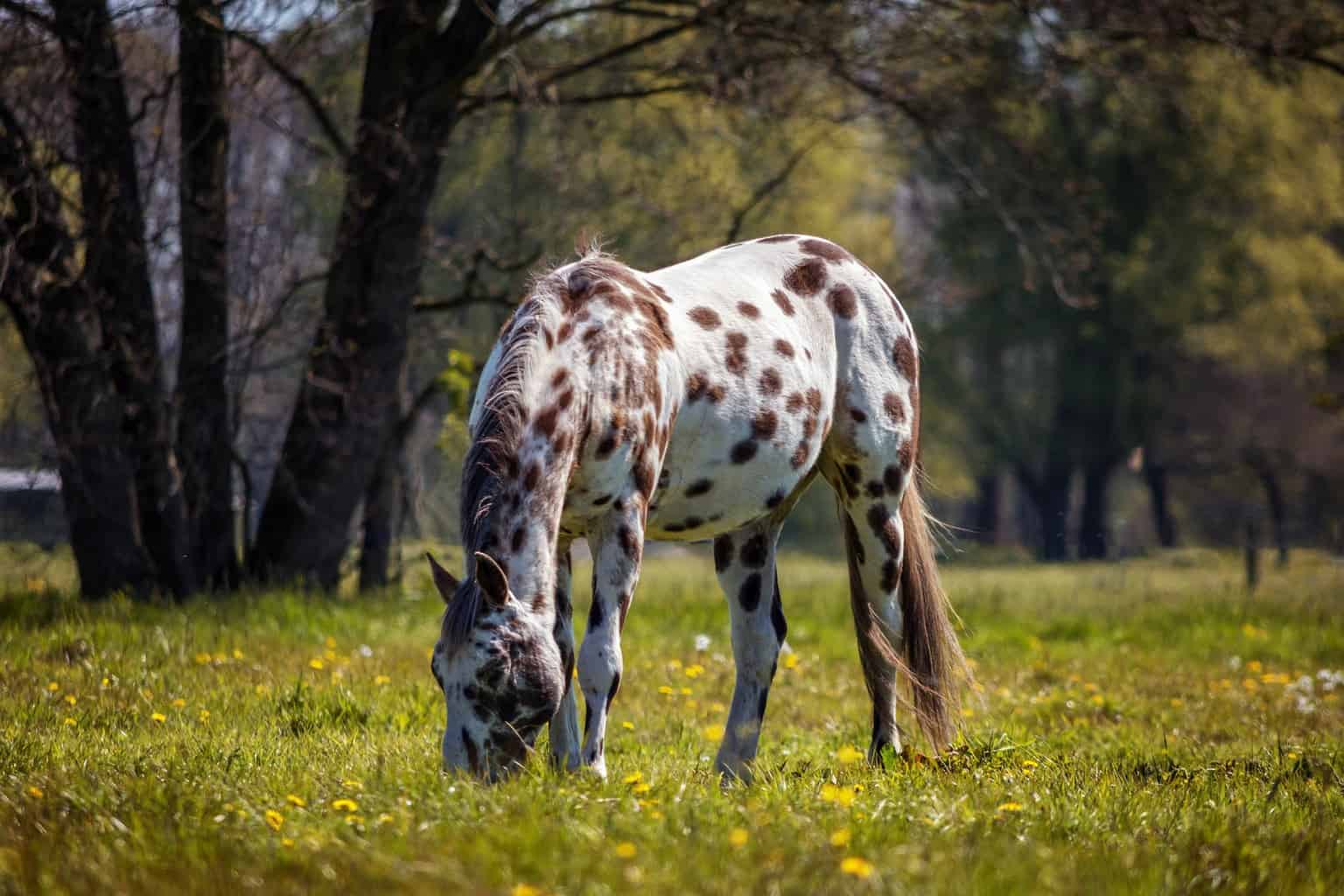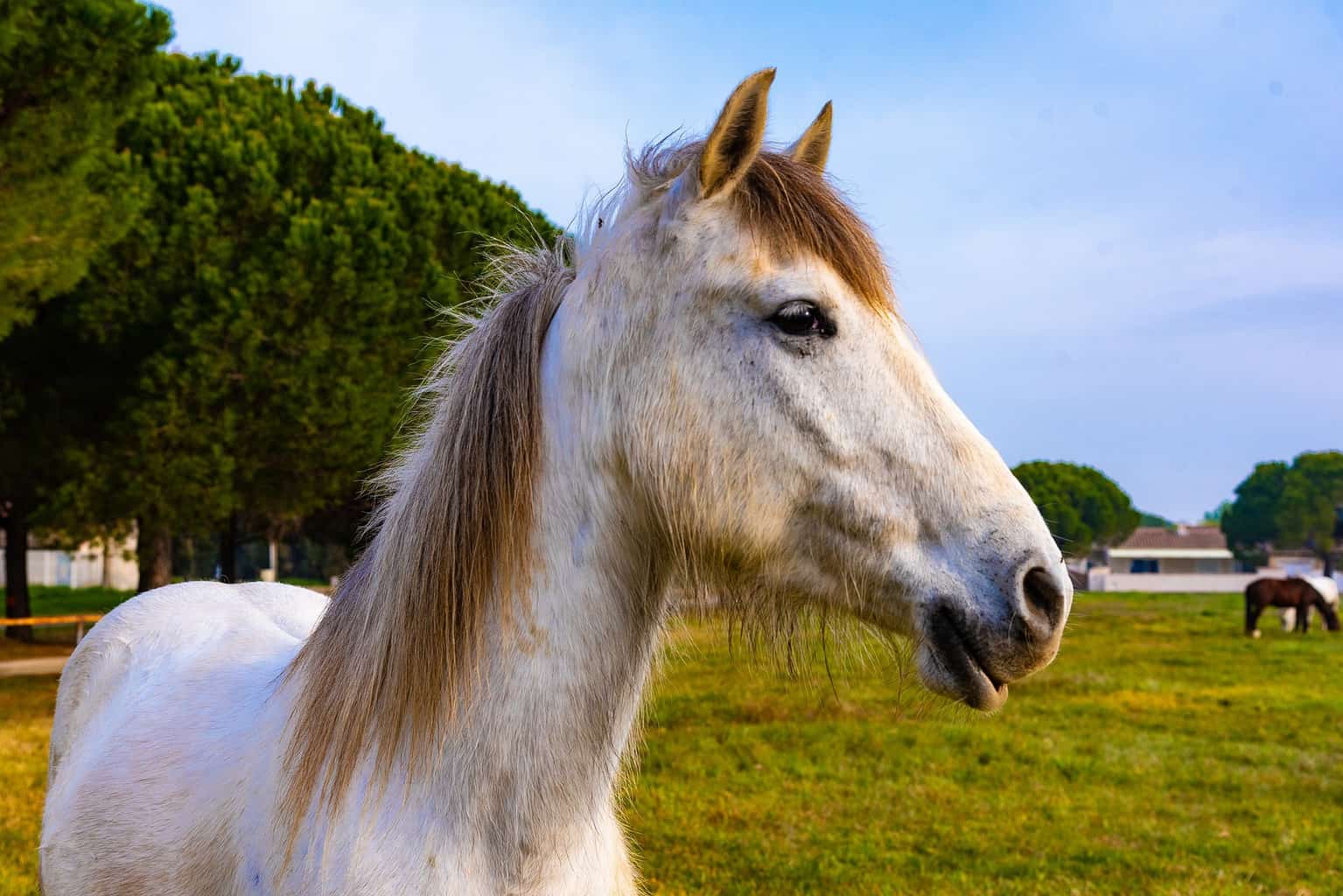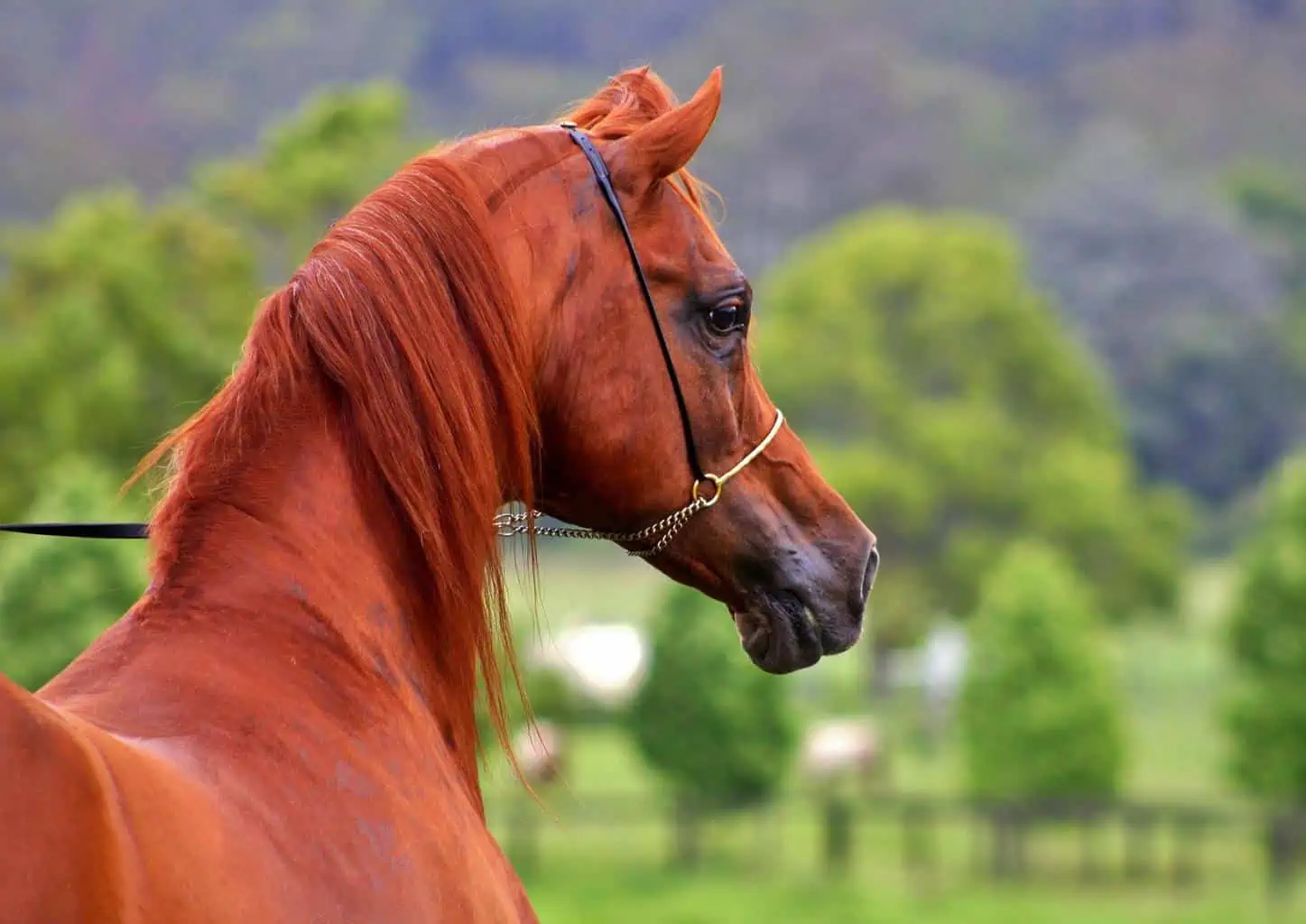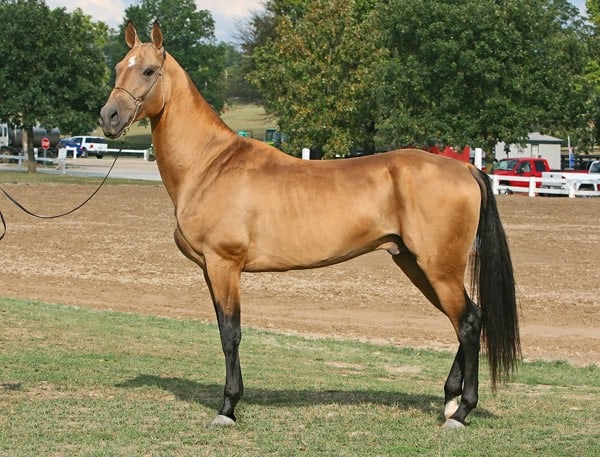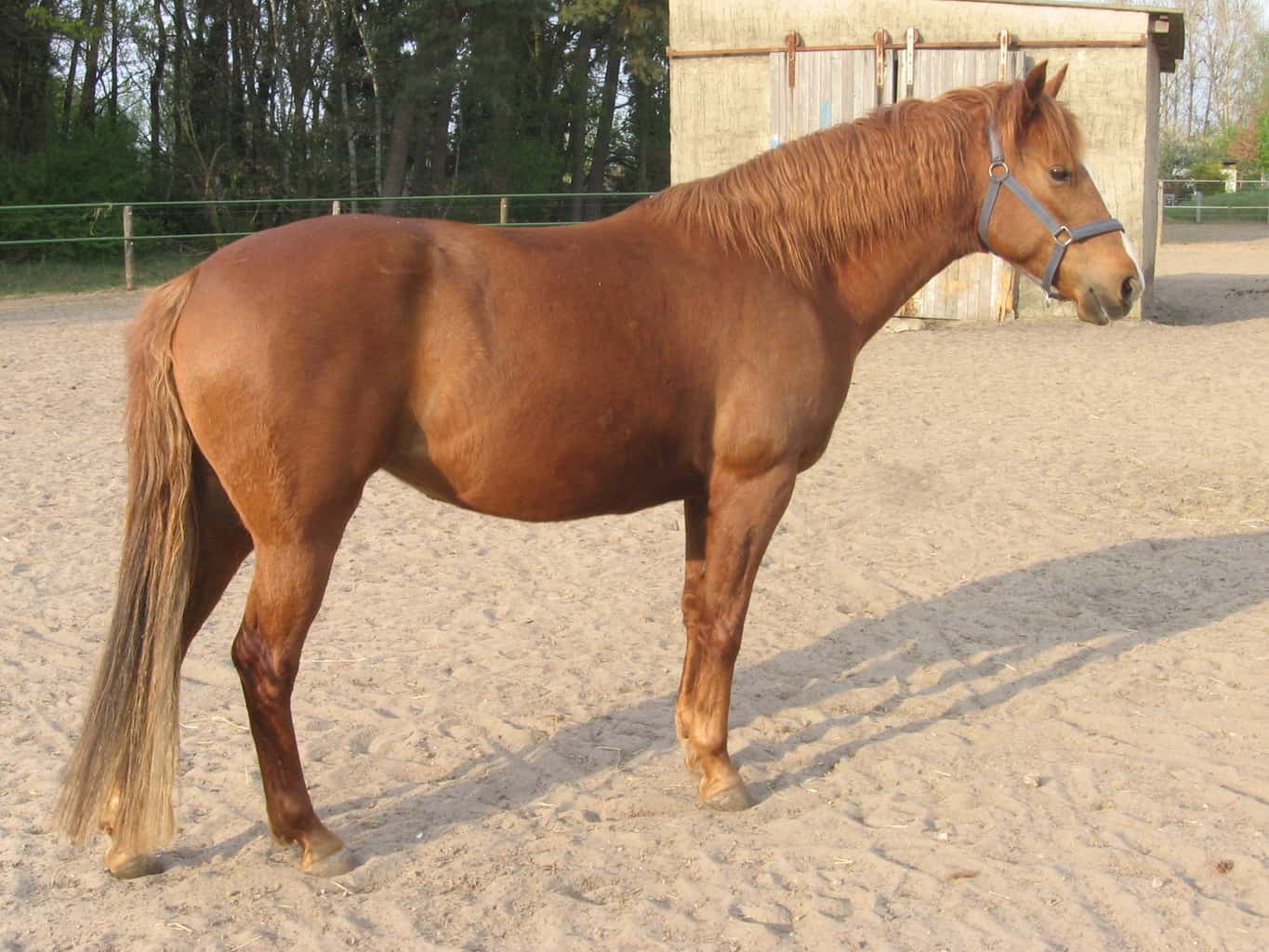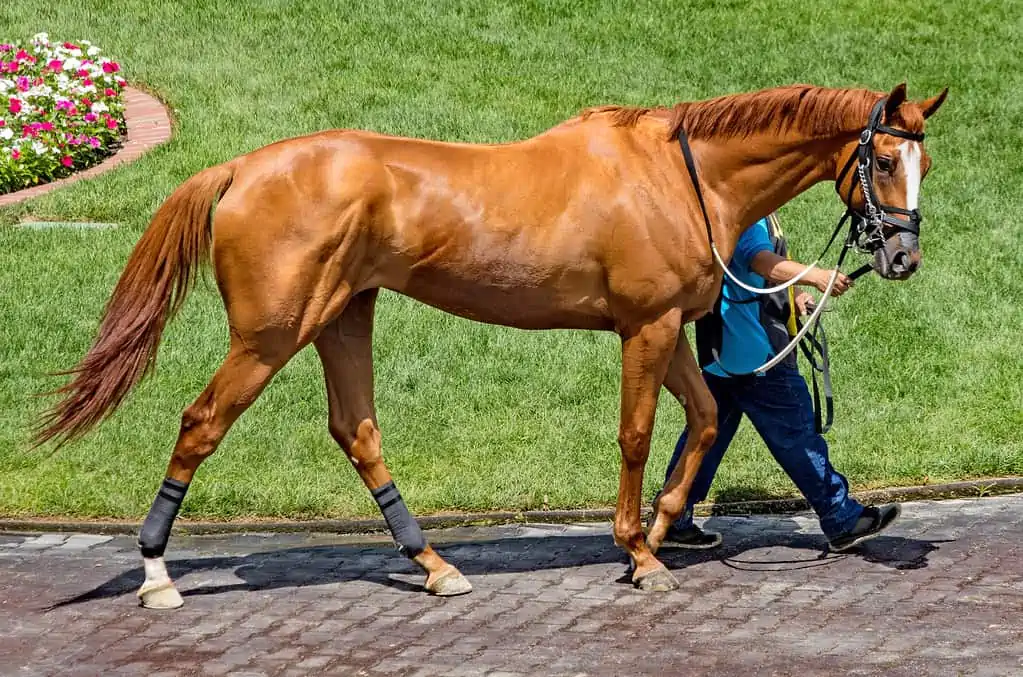- Parts of a Western Saddle Explained - May 19, 2022
- Parts of the Saddle Explained - May 19, 2022
There are over 200 horse breeds worldwide, though the actual number is widely debated. Each one has been shaped by careful selective breeding over the past 6,000 years, to create the perfect horse for every job and habitat. While almost any horse can be trained for horseback riding, some of these breeds are more suited to being ridden than others.
Though there are many exceptions to the rules, horse breeds can be divided into basic types. In this article, I will introduce you to many popular breeds of horse and explain the commonly-referenced categories of horse types. These include ponies, cold blood or heavy horses, warmblood and middle-weight horses, and finally, the hot blood horses.
Ponies
The key difference between a pony and a horse is their height. Horse breeds that grow to less than 14.2 hands (58 inches) high at the withers are ponies. However, some breeds don’t conform to this height standard and are popularly considered to be “small horses” or “large ponies”. Why is this?
Size is not the only thing that sets ponies apart. Their confirmation is important. This means the way that their body is put together in size, shape, and stance. Ponies tend to be stockier, and are much stronger than most horses, pound-for-pound.
Pony breeds that have not been refined by selective breeding also tend to be well-adapted for life in rugged natural environments such as mountainsides and moors. Most pony breeds have thick, flowing manes and dense, hairy coats to keep them warm and dry.
Temperament is also important, but a difficult factor to make objective judgments on. Ponies tend to be stubborn and cheeky, though this is not always the case.
Shetland Pony
Shetland ponies are the smallest horse and the breed standard must not exceed 107cm. They originate from the Shetland Islands of Scotland and can come in any color. However, spotted is not accepted by the breed standard.
Over the years, Shetland ponies have fulfilled many working roles. Their adaptable and friendly nature helped them to cope with working in the mines of Scotland. Shetland ponies have also been utilized to pull carts and farm machinery, but in modern times are best-loved as pets and children’s riding ponies.
In the 1880s, the Shetland pony was exported to the USA, where it was crossbred with a variety of other horse and pony breeds to create the American Shetland Pony. The American Shetland Pony stands a little higher and is a little slimmer than the classic shetland.
Exmoor Pony
The Exmoor pony has lived on Exmoor in the United Kingdom for thousands of years. They are perfectly adapted for the rugged terrain and many still live wild today.
However, each year many foals are sold as riding ponies following the autumn round-up, health check, and count. Exmoor ponies make wonderful, sure-footed ponies for young children, though they certainly have a stubborn streak.
Exmoor ponies are brown, showing colorations of dun, bay, and dark brown. But, they have signature blonder, buff-colored patches of hair encircling the eyes and mouth. They stand on average at just over 12 hands high. Find out more about Exmoor ponies by visiting the Exmoor Pony Center.
Welsh Mountain Pony
The Welsh pony is a native breed to the United Kingdom. The breed standard divides the breed into 4 modern ‘sections’. All descend from the ancient wild ponies of the Welsh mountains, called the Carneddau pony. Welsh ponies are exceptionally intelligent and hardy.
The Welsh Mountain Pony (Section A) stands at under 12 hands high and is widely acknowledged to be the world’s most beautiful pony. The Welsh Pony (Section B) stands at under 13.2 hands.
The Welsh Pony of Cob Type (Section C) also stands at under 13.2 hands, but is much stockier, compact, and stronger in its build and often has feathers around the hooves. The Welsh Cob (Section D) has no upper height limit and often crosses into the realm of being classed as a horse.
All Welsh ponies make excellent mounts for children, with the cob types being capable of carrying adults too. Thanks to their calm nature and suitability for a wide variety of riders, this breed is very popular and has been crossbred to create many sub-breeds of pony.
Connemara Pony
The Connemara pony is a native breed to County Galway, Ireland. As with other native ponies, Connemaras are hardy and sturdy, but also exceptionally agile. They make great jumpers and do very well for trekking cross country, where they may need to jump walls and ditches.
The Connemara pony is a larger breed and can vary between 12.2 and 15.2 hands high. But, they must be 14.2 hands or under to meet the breed standard. They express a wide range of colors but are usually seen in gray or dun. They are gentle, willing to work, and easy to handle.
Highland Pony
The Highland Pony is a native breed of Scotland, originating in the highlands. It is a large breed of pony, standing at a maximum of 14.2 hands high for breed registration. They have long, thick manes and tails and have feathers on their lower legs to protect them from the bitter winters of the highlands.
The height, hardiness, strength, and beauty of the Highland Pony have made them ideal for many different roles throughout history. Highland ponies work in agriculture and forestry, even today, but also make wonderful riding ponies, driving ponies, and show ponies. Thanks to their surefootedness in their native habitat, they also excel as mounts for deer stalking and hunting.
Quarter Pony
The Quarter Pony was established as a breed in the 1960s in the USA. The breed standard aims to emulate the popular build and temperament of the Quarter Horse, boosted by the stamina and hardiness of pony breeds. The Quarter Pony stands on average at 13.2 hands high, and cannot exceed 14.2 hands high to be breed registered.
The Quarter Pony is calm, strong, and ideal for Western riding activities such as barrel racing and rodeo. As with the Quarter Horse, his stance is well balanced, and he can turn and stop with incredible agility. This breed is perfect for young riders or adults that don’t wish to handle a larger horse.
Pony of The Americas
The Pony of the Americas breed came to be in 1954; the result of an Arabian/Appaloosa mare bred with a Shetland pony stallion. The foal was gentle and easily trainable. His appearance blended the small head of the Arabian horse, the well-muscled body of the quarter horse, and the beautiful spotted markings of the Appaloosa horse.
The Pony of the Americas Club was created to continue the success of this new breed, with rigorous standards. The breed has been carefully cultivated to create a pony with a horse-like confirmation, that must stand at no more than 13.2 hands high. Today, the Pony of the Americas gives confidence to young riders in many disciplines of competition and trail riding.
Coldblood Horses
The term “cold-blooded” is used to describe heavy-horse or draft-horse breeds. Coldblood horses were originally bred for laborious farm work such as drawing carts and plows. Their immense strength and power also made them perfect for carrying heavy weapons and knights wearing armor.
However, cold blood horses are not suited to racing, or for moving quickly over long distances. They tend to be mellow and calm in temperament, and not reactive or jumpy. Coldblood horses hail from the European region. They are often built to withstand harsh winters. Therefore, coldbloods usually sport thick manes and long hair (or feathers) around their hooves.
Modern agriculture relies heavily on machinery, As a result, many coldblood breeds are no longer kept and bred to the same extent as they were a century ago. This has led to the decline of many heavy horse breeds.
Nowadays heavy horses are usually shown in hand or pulling carts. Some cold bloods still work in agriculture and forestry, in places where machines can’t go or can’t be afforded. Some breeds can make lovely riding horses, but cold bloods tend to be larger and stronger than is ideal for most pleasure riders.
Belgian Draft Horse
The world’s largest horse was a Belgian Draft Horse named Jake, who stood at almost 20.3 hands high. On average, the Belgian Draft Horse is 16 to 17 hands high. The colors are usually bay, black, and chestnut, plus roan versions of each.
The Belgian Draft Horse descends from the warhorses of the Middle Ages. Breeding programs for the Belgian Draft began in the 17th century, and the studbook was begun in 1886.
Today, the Belgian Draft is the most popular draft horse worldwide and has been exported to the USA and across Europe. However, due to the dramatic decline in the use of draft horses for agricultural work and transportation, the breed has dramatically declined and is carefully maintained by the studbook organization.
Gypsy Vanner Horse / Irish Cob
The Gypsy Vanner or Irish Cob was carefully bred by Romani gypsies to create a powerful but compact horse that is ideal for both driving and riding. Gypsy Vanners stand between 13 hands and 15.2, making them much smaller than most other heavy horse breeds.
Gypsy Vanners would pull the caravans that served as moving houses in the nomadic Romani gypsy culture. The horses needed to be very calm, tolerant, and unlikely to spook, lest they damage the caravan or injure members of the close-knit community. The Gypsy Horse Association specifies that Vanners should be kind, intelligent, and work harmoniously with their handler.
Thanks to their exceptionally strong build, manageable size, and calm temperament, Gypsy Vanner Cobs are ideal for novice adult riders. As a result, this breed makes up the vast majority of school horses and riding horses in trekking stables for tourists.
Friesian Horses
Friesian horses are incredibly beautiful and make wonderful riding horses as well as carriage horses, thanks to their gentle and stable temperaments. Historically, they were used for lighter agricultural work and made impressive war horses.
Friesians have incredible, flowing manes and tails that can reach the ground. Their hooves are heavily feathered. Their color is almost always black, and they stand on average at just over 15 hands. Their bloodlines are ancient and originate in the Netherlands.
The breed has been influenced by Andalusian bloodlines and therefore is technically a warmblood horse. There is some debate as to which category this breed belongs in. Their warmer blood can certainly be easily seen in their high gait and lighter bone structure than that of most heavy horses.
Shire Horse
Shire Horses are calm and have mellow temperaments. The Shire Horse is strictly black, brown, gray, or bay. Stallions stand at over 17 hands high to the withers and weigh more than 1100kg! Mares are 16 hands high or taller.
These giant and powerful horses have worked in agriculture, forestry, and wars. However, they are most well known for towing barges and longboats along with the canal system of the UK. Following the mechanization of transport and agriculture, the population of the Shire Horse declined drastically However, the breed is seeing a resurgence in popularity as a horse for driving and riding today.
Suffolk Punch Horse
The Suffolk Punch Horse breed is the oldest draft horse breed in the UK. It can be traced back to 1768. The Suffolk Horse Society, which manages the studbook for this breed, was founded in 1877. The breed is critically endangered.
Originally, the Suffolk Punch Horse was bred to be powerful enough to plow the tough clay soil in the East Anglia region of the UK. However, since the rise of machinery in farming, the Suffolk Punch is being used for more diverse purposes, including timber haulage, riding, parades, and shows.
The Suffolk Punch Horse is always chestnut in color. In contrast to many cold blood breeds, the Suffolk Punch should be clean-legged and has minimal feathering at the hooves. Their height is between 15 ¾ hands and 17 hands.
Noriker Horse
The Noriker Horse is one of the oldest draft horse breeds in Europe and originates in Austria. They have incredible stamina and were used both for agricultural purposes and to transport heavy goods over long distances.
The Noriker is a medium-sized draft horse, It stands at around 16.2 hands-on average and weighs 700 kg. Noriker horses come in a wide range of colors, including very attractive pied, roan, and even leopard markings. It is extremely sure-footed and graceful.
While the Noriker horse is best suited to draft work, its smaller size makes it an enjoyable riding horse. It has an enjoyably smooth gait and a very gentle temperament.
Middle-Weight/Warmblood Horses
Warmblood horse breeds were created by breeding together cold-blooded heavy horses from Europe with hot-blooded light horses from the Middle East and North Africa. Warm-blooded horses embody the best of both ancestors, offering mellow temperaments alongside adaptable athletic abilities.
Almost any middle-weight horse could be technically referred to as a warmblood. This is true despite the breed has existed for many generations since the crossing of cold and hot ancestors occurred. In reality, when people use the term warmblood they are usually referring to purpose-bred sport horses. For example, most horses that compete in show jumping or dressage are purpose-bred warmblood sport horses.
Morgan Horse
The Morgan Horse was created in the United States and is regarded as the first American breed of horse. The Morgan Horse has an exceptionally gentle temperament and is very willing to work and keen to please people.
Morgan horses stand between 14.1 hands and 15.2 hands, so they are well sized for a wide range of riders. Because of their gentle natures, they are well suited to children and novice riders. However, they are not limited to riding schools.
Morgan Horses are deeply muscled and truly athletic. They do well in almost all disciplines. They can be driven, ridden in the outback, raced, jumped, and even do well in dressage. These horses are great all-rounders in every sense.
Dutch Warmblood Sport Horse
Dutch Warmbloods are true sport horses, bred very deliberately from a selection of European breeds to create a refined riding horse. They stand at 16.2 hands-on average and come in a wide range of colors including bay, gray, black, and chestnut.
Dutch Warmbloods are heavily muscled in the hindquarters, giving them an extremely powerful jump. They are used to competing at the highest level of showjumping competition and also excel in dressage. This breed is very intelligent and very eager to perform.
Irish Sport Horse
The Irish Sporthorse was created by breeding together the thoroughbred horse and the Irish Draft Horse to create an extremely fast, powerful, and muscular horse. The Irish Sport Horse is an incredible showjumper and shows courage, intelligence, and a forward-going nature.
But, the Irish Sport Horse is also renowned for its soundness, surefootedness, and sensibility. It is a fantastic horse for somebody ready to move from learning on cobs and cooler blooded horses into the world of competition.
The Irish Sport Horse stands at 15 to 17 hands high and weighs around 600 kg. Their bodies are strong but refined. They express every color, except for piebald and skewbald which are not accepted by the breed standard.
Hanoverian Horse
The Hanoverian Horse is a sport horse that originated in Northern Germany, where the studbook was established in 1888. There has been a renowned horse-breeding industry in the region for over 400 years, and Hanoverians are an influential and sought-after breed of horse. Breed characteristics and the criteria for the studbook registration of stallions are extremely thorough and demanding.
The Hanoverian Horse stands between 15.3 and 17.2 hands high. They have a floating trot and rhythmic, rounded canter that impresses in the dressage ring. Chestnut, bay, gray, and black are the accepted color of the breed standard.
They are bold and spirited but have a grounded calm to their temperament. Hanoverian Horses are ideal horses for the competitive rider and do well in eventing and showjumping as well as dressage.
Appaloosa Horse
The Appaloosa Horse is a unique and distinctive horse breed that sports a coat covered in spots similar to that of a Dalmation dog. Appaloosas stand at 14.2 to 15.2 hands high, making them adaptable medium-sized horse.
This American breed originates from the Native American Nez Perce of Washington, Oregon, and Idaho. The breed was developed from spotted horses brought to the American continent by Spanish settlers and has been influenced by many breeds since.
The Appaloosa is not a sport horse bred for competition, but a stock horse, bred for rounding up livestock and moving fast over wild terrain. However, it is an extremely fast and agile horse that does well in almost all competitive fields. Its friendly temperament and calm nature mean it is ideal for growing young riders and more component novices.
Camargue Horse
The Camargue Horse originates in Southern France and is one of the oldest horse breeds in the world. The breed inhabits marsh wetlands and has evolved to be able to stand in flooded soil for long periods without contracting hoof issues.
All Camargue horses are gray. The foals are born brown and develop into white as they age. They are a smaller breed of horse, standing at only 13 to 14 hands, but are extremely muscular and compact.
Hot Blood Horses
The term “hot-blooded” is used to describe lightweight, extremely agile horses from the Middle East and North Africa. They are described as hot both because of the climates in which they evolved, and their feisty, reactive temperaments.
Hot blood horses are very resilient and can be ridden very quickly over long distances. Speed and stamina, as well as delicate features such as small, dished heads, are key features of hot blood horses. Hot blood horses excel at racing, but also have great success in other disciplines such as cross-country and showjumping.
Arabian Horse
The Arabian Horse is a most ancient breed that had begun to be domesticated by the people of the Arabian Peninsula before 1,500BC. They were bred to travel across desert and arid environments, and are extremely resistant to high temperatures and harsh conditions.
Arabian Horses have a unique shape with a small, dished head, short back length, and tail held high. They stand at 14 to 16 hands high. Bay, gray, black, roan, and chestnut are all colors of purebred Arabian Horses that are recognized by the Arabian Horse Association.
The Arabian Horse dominates the discipline of endurance racing, thanks to its compact, light build and incredible athleticism. However, they also excel in jumping and dressage and are challenged only by the thoroughbred on the race track.
Arabian Horses are not good horses for novice riders. They are extremely flighty and hot-headed. As well as being incredibly athletic and high-energy, they are also highly intelligent and need thorough training and a lot of mental stimulation.
Akhal-Teke Horse
The Akhal-Teke is a lesser-known hot blood breed than the Arabian Horse but may predate it. Records of the Akhal-Teke reach back as far as 3,000 BC. Also a desert horse, the Akhal-Teke was used to carry out lightning-fast raids on rival tribes.
The Akhal-Teke is an incredible endurance horse and can cover vast distances across the desert with minimal water. The Akhal-Teke stands at 15 hands-on average and is incredibly beautiful. They have a unique, almost metallic coat that gleams. Akhal-Tekes express many colors and often have blue eyes.
Akhal-Teke Horses were traditionally not kept in herds. Instead, they were tethered individually outside the homesteads of their owners. Possibly as a result of this unique domestication process, Akhal-Tekes behave differently from other horses.
They can be territorial and protective of their owners. They tend to bond with very few people and do not adapt well to changing owners. Akhal-Teke Horses are challenging and are not suited to inexperienced riders.
Barbary Horse
Commonly referred to as the Barb Horse, this breed is native to North Africa. It is related to the Arabian Horse but is larger and holds its tail lower. The Barb Horse stands at around 13.3 to 15.2 hands high. Like the Arabian and Akhal-Teke Horses, the Barb is well adapted for life in the desert and does well in endurance trials. The Barb horse had a great influence over the development of Anglo hot blood and warmblood horses.
English Thoroughbred Horse
The English Thoroughbred Horse was developed under the scrutiny of the British Royal Family in the 17th and 18th centuries. Three stallions, known as the foundation stallions, were imported to England by gentlemen who were interested in horse racing. These were The Darley Arabian (an Arabian Horse), The Godolphin Barb (a Barbary or Arabian Horse), and The Byerley Turk (an Akhal-Teke Horse).
The three stallions were carefully bred with the Royal Mares, which was the title given to mares of the royal stud stable. DNA analysis shows that the mares that founded the thoroughbred line were a mix of hot blood horses from the Arabian Peninsula and choice British and Irish cold blood mares.
The resultant Thoroughbred breed of horses was faster than and more powerful than any horse that had come before. In modern times, flat racing and steeplechase are entirely dominated by the Thoroughbred Horse breed. Thoroughbreds stand on average at 16 hands high.
Despite the Thoroughbred technically being a blend of hot blood stallions and cold blood British mares, the breed is still defined as hotblooded. This is partly because of the strong proportion of their genetics coming from hot blood ancestors, but also due to their temperaments. Thoroughbred Horses are highly reactive, sensitive, and spirited.
Types of Horse Breeds: FAQs
Answer: Keeping breeds of horses separate through the generations is difficult and is often carefully managed. There are only one species of the domestic horse. This means that any mare and stallion from any breed can mate and produce offspring that are viable; meaning that the offspring can successfully have their offspring.
As a result, it would be very easy for breeds of horses to become blended through accidental or indiscriminate breeding. If this happened, they would lose the unique attributes that make them well suited for their environment or their role in our society.
There are two ways to prevent this from happening. One is geographical isolation, which is how natural horse breeds developed without human intervention.
Some breeds of horses, such as the Icelandic Horse, are completely isolated from other breeds and have been for thousands of years. There are no other types of a horse on the island of Iceland for the horses to come into contact with. So, the breed stays pure.
The second way is through enforced or artificial isolation of a breed’s genetic pool. This is done using stud books and breed registration.
In summary, to register a horse with a breed managing organization, the horse must be judged against the set breed standards. Horses that do not meet the breed criteria, or who have questionable parentage, may not be accepted into the breed register.
If a stallion or mare has been accepted and registered, it may be matched with an appropriate reproductive partner. The matches are calculated to develop the body and temperament of the breed in certain ways over generations. Proper planning should also keep the gene pool diverse and healthy.
Answer: The origin of horses is a fascinating story with many twists and turns. Fossil evidence tells us that the ancestors of the modern horse first evolved in North America.
From North America, horses spread into the Eurasian continent via the Bering land bridge. They spread across the continent(s) and slowly evolved to be perfectly adapted to the wide range of environments they encountered.
Horses roamed the American continent until around 10,000 years ago when they became extinct. Theories suggest that diseases, climate change, or human influence could have caused this.
Horses were famously reintroduced to the American continent by explorers Christopher Columbus in 1493 and Hernan Cortes in 1519. Previous to this reintroduction, there were no horses on the American continent.
Answer: The best horse for a new rider should be well suited for the size and weight of the rider, as well as calm and tolerant. Most children will begin with ponies such as the Welsh pony, Morgan pony, or Shetland Pony.
Almost all adults begin learning in riding schools, where they are likely to ride Welsh Cobs or Irish Vanners at first. Once a rider begins to progress they may move onto calm warmblood horses such as the Appaloosa, the Morgan horse, or even an Irish Sport Horse.
But, what is more, important than the breed, is always the temperament of the individual horse. Always follow the guidance of your riding instructor, who will match you with your ideal horse.
Read More:
• Worst Horse Breeds for Beginners
• Pony vs Horse: What’s the Difference
• Shire Horse vs Clydesdale Comparison

